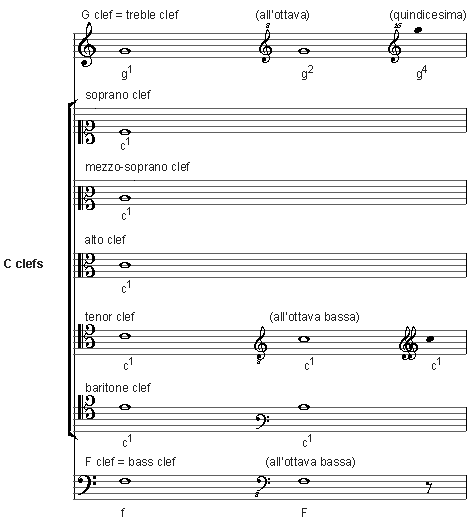Clefs - Musiikin teoria 1
Clefs
A clef indicates the location of a certain note on the staff. Instead of a score, medieval and renaissance vocal polyphony mainly used part books with staves written densely below each other because that was cost-efficient. Each part was written to fit the range of the staves; that is why the Middle C was located differently in different parts: for baritone it was on the top line, for soprano on the bottom line. The C clef was also common, especially in choral music up to the end of the 18th century. Moreover, instrumental music also preferred changing clefs instead of adding ledger lines.
The most common clef today is treble or G clef. Its original form resembled the letter g, but as early as the 16th century, the upper part began to resemble the letter s, probably because the note g was replaced by the syllable S(ol) in solmization.
The bass or F clef originally resembled the letter f, but the horizontal lines were replaced by dots early on. In the course of time, the shape of the C clef has also changed considerably from the original letter c.
The example below presents the most common clefs and some notes with note names. The alto clef is used by violists; the tenor clef is familiar to cellists, bassoonists, and trombonists. Other C clefs are mostly seen in choral music. It is commonplace for publishers to replace C clefs written by composers with more familiar treble and bass clefs. Moreover, in choral music, the tenor clef resembling the treble clef is quite common.
Another clef worth mentioning is the French violin clef with a G clef written on the bottom line. The most common clef for percussion nowadays is two, thick, parallel vertical lines.
In the 18th century, musicians were still well versed in C clefs. A contemporary textbook on figured bass included the instructions for easy transposition: Just imagine another clef at the beginning (!).
Knowledge of clefs is still necessary, for example in solfège or ear training, as a staff without a clef indicates no pitch. On the other hand, a note on any line or space of the staff will have any of the names C, D, E, and so on, depending on the clef.
C clefs

It may be easier to perceive all C clefs by imaging that the staff has 11 lines with the 1st octave C on the middle line. The example below shows that the C clef is located in between the G and F clefs (the clefs are a fifth apart).

Note that names can be learned with the help of a series of third intervals: in the alto clef, the notes on the lines are F-A-C-E-G; in the tenor clef, the notes are D-F-A-C-E, and so on.
